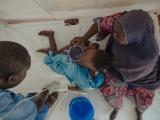Aug 24, 2011 (CIDRAP News) – A whole-genome sequencing study of Haiti's cholera outbreak strain has produced strong evidence that United Nations peacekeepers from Nepal brought the disease into the country, according to a study published yesterday.
And today researchers who used advanced sequencing to explore cholera strains from the last 40 years have mapped the spread of the pathogen during the world's seventh pandemic of the disease, which includes Haiti's outbreak. They found that waves of cholera drove its intercontinental spread and that acquiring antibiotic resistance influenced spread of the disease.
The first study was headed by a group at Translational Genomics Research Institute (TGen), based in Flagstaff, Ariz., that also included collaborators from Denmark and Nepal. The authors include Dr. Paul Keim, who used similar genetic tracking techniques to help the FBI identify the source of the 2001 anthrax letters.
The group published its findings yesterday in mBio, the online open-access journal of the American Society for Microbiology.
According to the latest update from Haiti's health ministry, the outbreak has so far sickened 428,785 people and killed 6,194.
A cholera outbreak struck Haiti about 9 months after a massive earthquake devastated parts of the country. Suspicion focused on Nepalese soldiers serving in a disaster-response capacity at a UN peacekeeping base where sewage was dumped into the Artibonite River, which fueled civil unrest.
On May 4 an independent panel convened by the UN stopped short of blaming the peacekeepers for the outbreak, emphasizing that the epidemic couldn't have happened without serious deficiencies in Haiti's water, sanitation, and health systems. Two days later a detailed epidemiologic investigation led by French researchers built a stronger argument that the soldiers from Nepal imported the outbreak strain into Haiti.
Matching Nepalese and Haitian strains
In the mBio study, researchers used whole-genome sequence typing, pulse-field gel electrophoresis (PFGE), and antimicrobial susceptibility testing to characterize 24 recent Vibrio cholerae isolates from five districts in Nepal with 10 previously sequenced isolates, including three from Haiti's outbreak. They noted that a cholera outbreak began in Nepal in July 2010 and was controlled by the middle of August, right before the soldiers left for Haiti.
Antimicrobial susceptibility and PFGE tests supported the epidemiologic link between the isolates from Haiti and Nepal. The Nepalese isolates were susceptible to tetracycline but resistant to trimethoprim, sulfamethoxazole, and nalidixic acid, with decreased susceptibility to ciprofloxacin, consistent with the Haitian isolates.
Genome testing found that the Nepalese isolates fell into four closely related clusters, one of which contained three isolates that were nearly identical to three Haitian isolates. They reported that the identification of several subclades in Nepal suggests that the disease there is prevalent and that water hygiene improvements and other investments are needed to stem the spread of disease in that country.
Dr Frank M. Aarestrup, a Danish collaborator, said in a statement that the study underscores how rapidly infectious diseases can spread through international travel and how public health officials need both advanced molecular tools and standard epidemiological investigations to quickly and accurately pinpoint the sources of outbreaks.
The authors wrote that they hope that in the future, rapid molecular diagnostics can be integrated into screening programs for relief workers so that their response efforts aren't tainted by infectious diseases.
40 years of pathogen evolution
In the Nature study, an international collaboration led by the UK-based Wellcome Trust Sanger Institute (WTSI) used whole-genome sequencing to explore DNA changes in V cholerae isolates from 154 patients across the world over the past 40 years.
They traced the cholera type—the El Tor strain—responsible for the current pandemic to an ancestor that first appeared 40 years ago in the Bay of Bengal, according to a WTSI press release. From there the bacteria spread in multiple waves to different parts of the world, including Africa, South Asia, and South America.
They found that the bacterium first acquired antibacterial resistance in 1982, which renewed transmission across the globe from the original source.
Dr Julian Parkhill, a senior group leader at the Sanger Institute and senior author of the study, said in a statement that the findings challenge current beliefs that cholera always arises from local strains, which is useful for understanding outbreak dynamics.
Spread of the strain involved at least three independent overlapping waves that showed strong correlations with human activity, suggesting that it was related to travel, the group reported.
Dr Nicholas Thomson, a Sanger Institute coauthor, said in the statement that the Bay of Bengal acts as a cholera reservoir. "By tracking how the disease is spread, our maps of transmission could influence future decisions on how to tackle this disease," he said.
See also:
Aug 23 mBio abstract
Aug 23 TGen press release
Haiti health ministry documentation page
Aug 24 Nature abstract
Aug 24 WTSI press release
May 5 CIDRAP News story "Experts link Haiti cholera outbreak to human actions, foreign strain"
May 9 CIDRAP News story "Study bolsters UN source for Haiti's cholera outbreak"
















